
 |
Recent Books by Forum Members |

 |
 |
|
|
|||||||
 |
|
|
Thread Tools | Display Modes |
|
#376
|
||||
|
||||
|
Quote:
In my small selection of shoulder titles, I have a curved NZMP which looks to be converted from a NZMR .I have no idea if it is a period or modern conversion. No biggie either way!! |
|
#377
|
||||
|
||||
|
Quote:
A period photo showing a clear example of an NZASC shoulder title that has been converted to a NZSC shoulder title is worth sharing, especially when it comes with the actual modified titles that are in the picture. Are you able to get a copy of the photo and the badges to share on this thread? |
|
#378
|
||||
|
||||
|
Quote:
The photo is out there, just a matter of tracking it down Puk |
|
#379
|
||||
|
||||
|
The earliest regulation published in regards to cloth patches worn by NZ Machine Gunners was ‘NZ Regulation No. 418A of December 1907’. —
“Non-commissioned officers and men in order to qualify for personal payments and efficiency badges for efficiency in the use of machine guns must have undergone an annual course in the use of machine guns, and have fired the allowance of ammunition laid down in General Regulations, in addition to which each non-commissioned officer and man shall undergo a practical examination by the Director of Artillery Services, and be required to qualify in the following subjects: General description of gun and carriage; care and preservation of machine guns; failures that may occur, and how to remedy them; drill for gun on issue to unit; filling belts with ammunition. He must also identify and know the use of all stores, spare parts, and fittings of Maxim or other machine guns. Sergeants, in addition, must possess a good knowledge of the employment of machine suns in the field. Badges and personal payments of £1 each will be granted to the eight best non-commissioned officers and men in each regiment or battalion who qualify in the above subjects.” The Maxim (“or other machine gun”) detachment efficiency badge description is mentioned in ‘NZ Regulation No. 601 of December 1907’. — “Proficiency badge, consisting of the letter "M" in red, the distinguished badge being the letter in gold.” The date of when the letters “MG” were first authorised as New Zealand’s official 1st Class Machine Gunners proficiency badge has so far eluded me, so I am open to any input on the subject. However I am inclined to think that the “M” machine gun proficiency badge would have only been in use up until at least 1911. The following photo I believe was taken during a military tournament at the Exhibition grounds in Christchurch on the 27th or 28th of December 1906. It shows the Wellington Guards Maxim gun detachments who were the overall winners of the Infantry Maxim Gun Drill competition and £8 prize money. The team comprised of Sergeant Baggett, Corporals Turby and Richards, Privates Smart, Tresize, Power, Fellingham, Hamilton, Tinney, Tricker, B. Smith, and H. Smith. (The Amuri Mounted Rifles won the Galloping Maxim competition and £6 prize money) 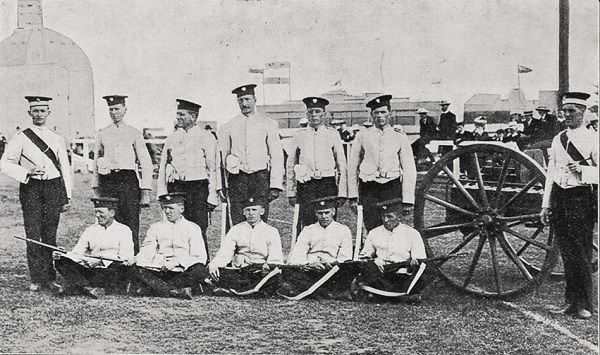 The following two photos were taken during Easter military manoeuvres held at Sheffield in Canterbury on the 30th and 31st of March 1907. Maxim guns from both Infantry and Mounted machine gun detachments played a very important part during the manoeuvres. Although the Maxim gun team in the pictures is unidentified, the .303 Model 1893 Maxim machine gun is mounted on a Dundonald Galloping Carriage, which I assume is a Mounted machine gun detachment. I have ruled out the Amuri Mounted Rifles whose uniforms had different facings, and am leaning towards it being the Canterbury Mounted Rifles Maxim detachment. (Note that a few of the machine gunners are wearing their felt hats in the Baden Powell [B.P] style) 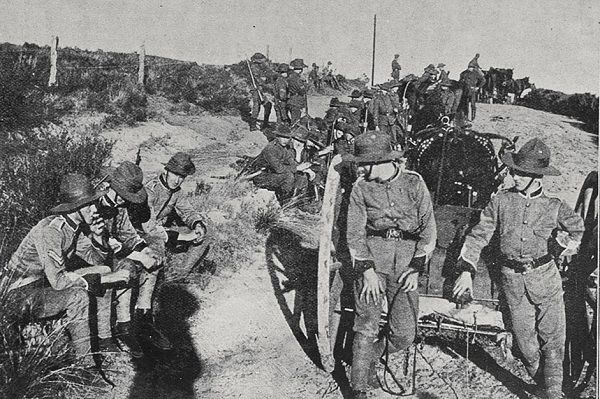 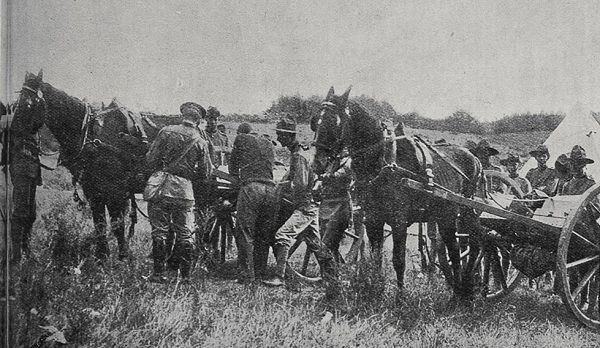
|
|
#380
|
||||
|
||||
|
New Zealand Military Forces. Dress regulations, 1912.
Distinguishing Badges and Chevrons, Paragraph 65. (1.) Badges. — Worsted, of a drab mixture. The ‘New Zealand 1912 Dress Regulations’ unfortunately do not include all the ‘Proficiency’ and ‘Skill at Arms’ badges that were available at the time, which really isn’t that unusual, as the New Zealand regulations at the time in regards to training, closely followed the British regulations, which themselves had only just been laid out in the 1912 ‘Kings Regulations and Orders.’ The following pictures of paragraph 683 were taken from page 152 and 153 (Section IX. — Training and Education) of the 1912 Kings Regulations. 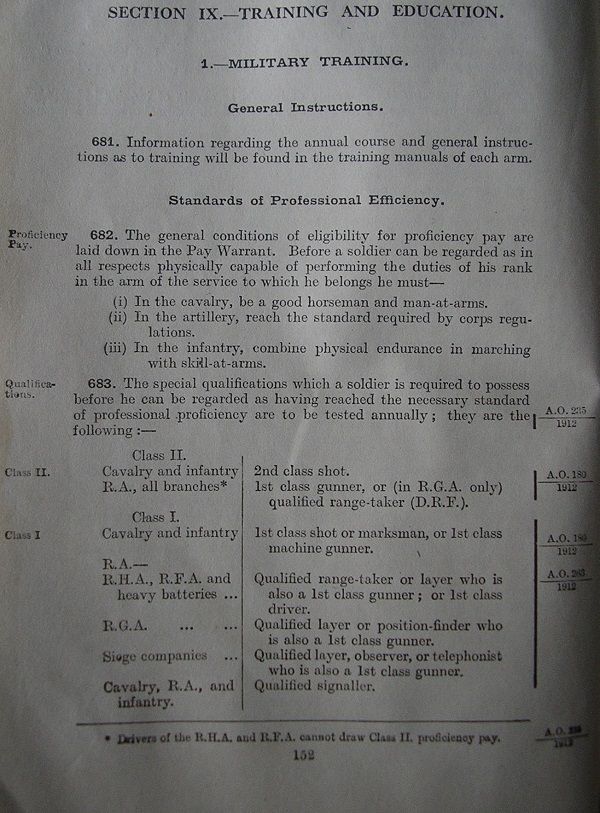  As can be seen in Army Order (A.O. 180 / 1912) the regulations regarding qualifications for ‘1st Class Machine Gunner’ distinguishing badges, are laid down in the “Musketry Regulations, Part 1, Para. 647.” The following pictures of page 230 and 231, show paragraph 647 from the Musketry Regulations that were kindly supplied by Mike D. (AKA ‘m-j-d’) 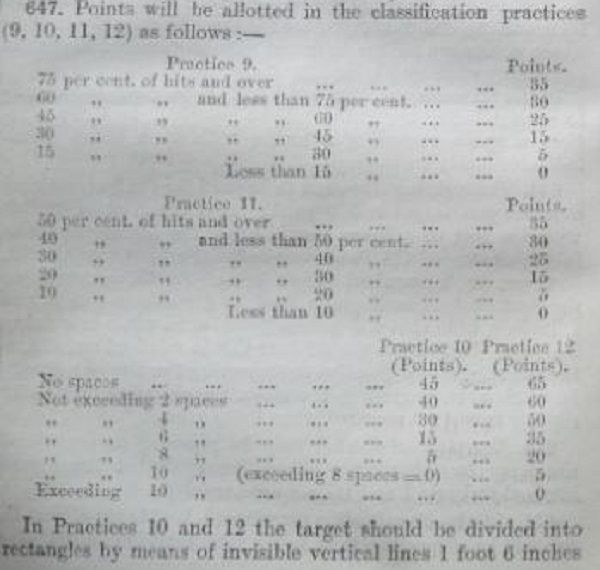  1st Class Machine Gunner distinguishing badge. 
Last edited by atillathenunns; 06-06-14 at 02:23 AM. |
|
#381
|
||||
|
||||
|
“Green puggaree —the puggaree made famous by the N.Z.M.R. Brigade in Palestine. The green puggaree is as honourable a badge as horse-soldiers have ever worn. It will be more famous in 2020 than in 1920, when the size of the Palestine stunt is understood.” (Observer newspaper, November 1920)
Unlike the famous green puggaree which is still currently worn on the modern NZ Mounted Rifles Hat (MRH), the New Zealand Mounted Rifles Machine Gun Squadron Distinguishing Patch has slipped into obscurity. Fortunately for us badge enthusiasts, Malcolm Thomas & Cliff Lord have included the following short paragraph on page 28 of their excellent book — “New Zealand Army Distinguishing Patches 1911 – 1991.” “General Chaytors Order No. 145, 31st October 1917, authorised distinguishing patches, 2 inches long by ¾ inch high, worn in the centre of the slouch hat puggaree on both sides.” Unfortunately my own research of the NZMR 1st Machine Gun Squadron war diary has only got as far as September 1917, so I am not sure if there is any mention of their distinguishing patch in their war diary for the months of October / November 1917, which is held in the Wellington Office of Archives New Zealand. (Record # R23925664) Fortunately I can supply the following extract from the Auckland Mounted Rifles war diary which gives an insight of when the Squadron distinguishing patches were first proclaimed.  The timing of General Chaytors Order No. 145 authorising distinguishing patches to be worn on the green mounted rifles puggaree, appears to have been introduced so as to easily identify the various New Zealand troops involved in General Allenby’s attack on the enemy's exposed left flank at Beersheba, and to roll up his line towards Gaza. “The (NZ) Squadron was stationed at El Fukhari at the beginning of October; it left there for Esani on 24th. On 28th it proceeded with the Brigade to Khalassa, the following day to Asluj, and at 5.30 p.m. on the 30th it moved out to the attack on Beersheba.” The following two pictures shows a 1918 Christmas card which has the NZ Machine Gun Squadron patch pictured on the inside of the card. 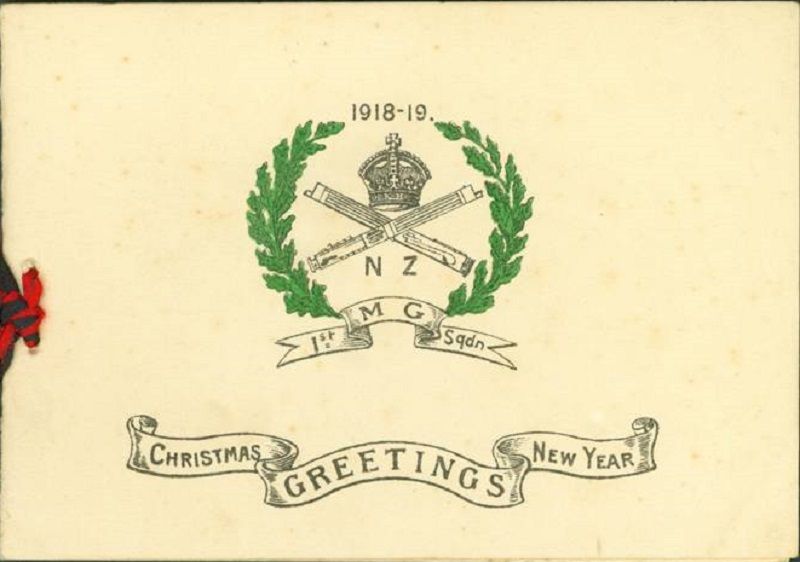 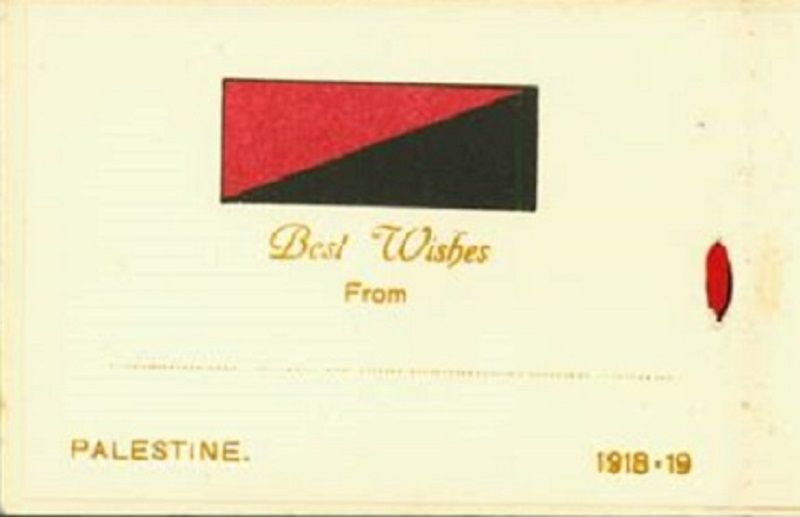 The following two pictures of a NZ Machine Gun Squadron patch on a Mounted Rifles puggaree were kindly supplied by Barry O’Sullivan, and feature on the cover of the most excellent reference book — ‘New Zealand Army Uniforms and Clothing 1910 – 1945’ — by Barry and Matthew O’Sullivan.  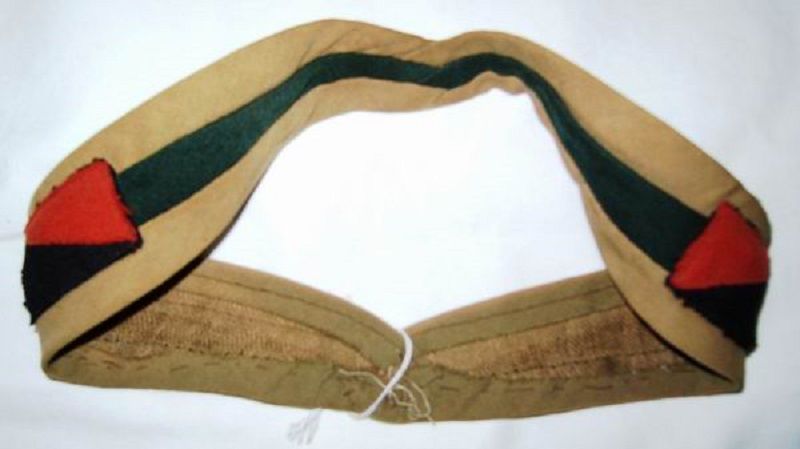 The puggaree originally belonged to Trooper Joseph Francis McKee, Service No. 48991, who embarked with the NZ 28th Mounted Rifles Reinforcements on the 7th June 1917, served with the NZ 15th Company Imperial Camel Corps and then the 2nd NZ Machine Gun Squadron. |
|
#382
|
||||
|
||||
|
Here is an unidentified NZ Machine gun section ,private, with ''stubby barrelled'' NZMGC cap and collar badges ,and a variation of the 1st class machine proficiency distinguishing patch on his lower left sleeve
|
|
#383
|
||||
|
||||
|
Puk your mans “Machine Gun M.G. in wreath” qualification badge and the one in post #369 apart from colour look similar, I can only speculate that they both were most likely made by P. Robert, and the black thread MG is matched to the black insignia worn by the NZRB.
|
|
#384
|
||||
|
||||
|
As mentioned earlier, prior to the start of this thread the most that had ever been written about the NZ Specialists Company was about two paragraphs, so the opportunity to share some of the Specialists badges and papers of Thomas Mitchell is about as good as it can get, and I would like to personally thank the family for allowing me to share Thomas’s souvenirs with this forum.
Thomas Mitchell started out his career in 1909 in Dunedin as a Telegraph Message boy, three years latter Tom enrolled at the Telegraph Learners School at Omaru. Upon qualifying at the School Tom was given a cadetship at the Tapanui Post Office. (Toms long career with the Post Office lasted 44 years, finishing as the Postmaster of Gore in 1953) Thomas Mitchell as a Telegraph Message boy standing on the right, and Bill Coup is on the left.  Prior to WW1, Thomas Mitchell served with the Territorial Post & Telegraph Corps. Tom was 22 when he enlisted at Winton recruitment office on the 30th November 1916. 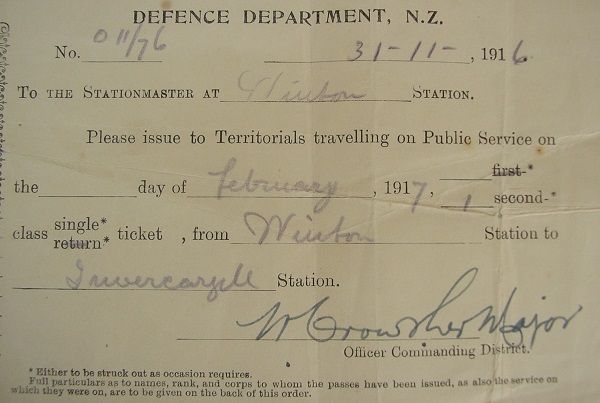
|
|
#385
|
||||
|
||||
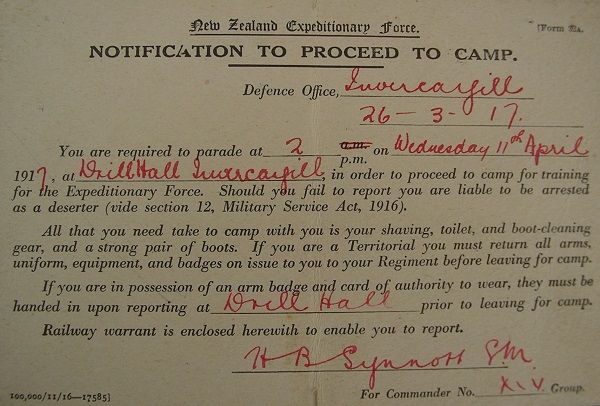 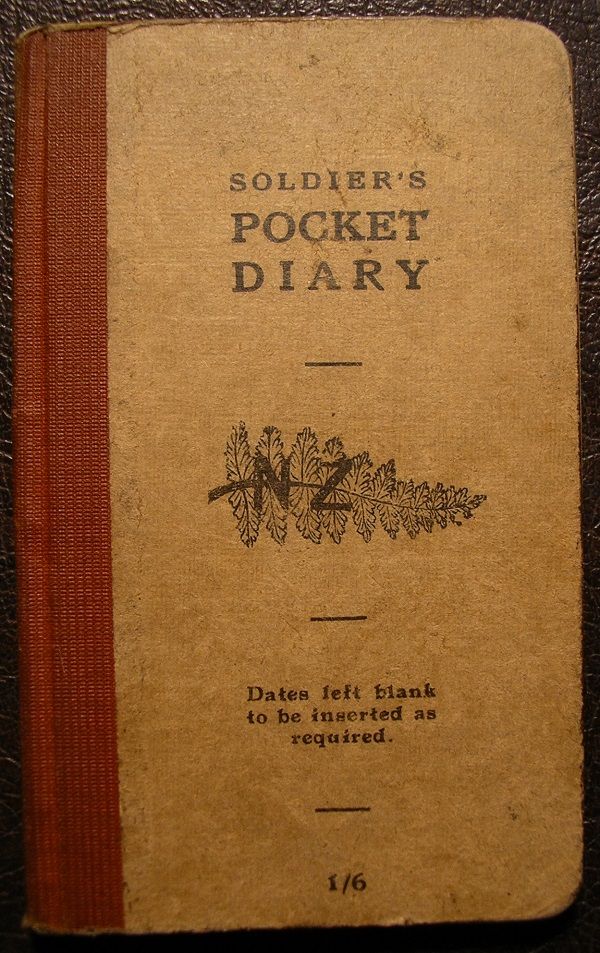 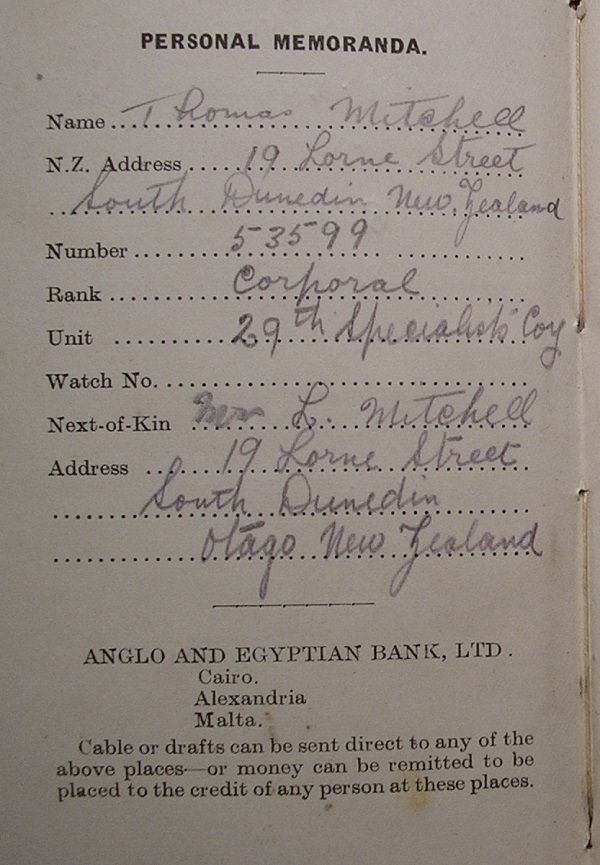 7th April 1917 (Saturday) Left Winton 6pm train for Invercargill, arriving there at 7.15pm. Stopped at Railway Hotel over Sunday, missed train for Dunedin on Monday morning, came on as far as Gore by slow train, and I caught the 2nd Express there, arriving in Dunedin at 6.30pm on the 9th, and by 7.30pm I was home having tea at my peoples place. In the meantime I had caught an awful cold and I was too crook to leave Dunedin on the Tuesday morning, so I stopped at home and never went outside the door, and cough, well I was absolutely sick of it. Anyway I felt a little better on the Wednesday morning and I left Dunedin with the 2nd Express for Timaru, and what a ride it was, the carriages were simply packed with soldiers returning from final leave, and they were all pretty merry all the way up; It was a sad sight-seeing mothers and sisters saying farewell to their sons on the Dunedin railway station, my dear mother was broken up over me going, but I managed to talk her over, and it was not so bad. I saw Adam Wilson on the platform at Oamaru, we had a nice little chat, then I arrived in Timaru about 5pm on the 11th. I found Timaru just as quiet as any of the other places, I spent a few quiet hours there, and in the morning I was going to the Post Office, and who should I meet but wee Peg Cowie and Ola Keith, and they said they were having a jolly good time, Peg was saying Vera did not stay in Christchurch very long, as she is back in Timaru again, I might see them at the train tonight. I spent a very quiet day in Timaru on the Thursday, and I was patiently awaiting the arrival of the Troop Train which arrived here at about 5pm, after leaving Timaru we had a non-stop run to lyttelton, upon arriving there we found it raining very hard and we all got very wet, before we boarded the boat (S.S Maori), we left Lyttelton shortly after 10pm and we had a very rough trip across the straights, I was very sick most of the journey, but upon arriving in Wellington I felt much better, we arrived there at 9.20am on Friday morning (13th April) and by midday we were landed in Trentham Camp. (Thomas Mitchell was officially posted to the 29th Reinforcements Specialists Company on the 12th April 1917) 13th April 1917, Trentham Camp First of all we were all medically examined and then we were drafted into our respective companies, we then had our lunch, after lunch we were given our full rig-out of clothing and Bill Masseys boots. On Saturday we were ready to go on with the first lessons of drill, everything went off well that day, but I started to feel feverish, after going to bed and I had been to the doctor twice beforehand, and each time I was given the good old cure (Salts), anyway they did me no good, and at about 2am on the Sunday morning I was taken to the hospital, and it was found that I had an attack of Tonsillitis, and a very nasty complaint it is, I was in the Cottage hospital for four days. In the meantime our company had moved to Featherston Camp, and I was put into details after coming out of the hospital, and on the Friday (20th April) I proceeded to Featherston to join my own company. On my arrival there I found all the huts were full and I was billeted in a hut with the 27th Specialists, and I was there for ten days until there was a vacancy in one of the other huts, I was very pleased to get with my own mates once more, and I have been happy and no cause to complain ever since, I am thankful to be able to say that I have enjoyed the best of jolly good health all the time I have been in Featherston. 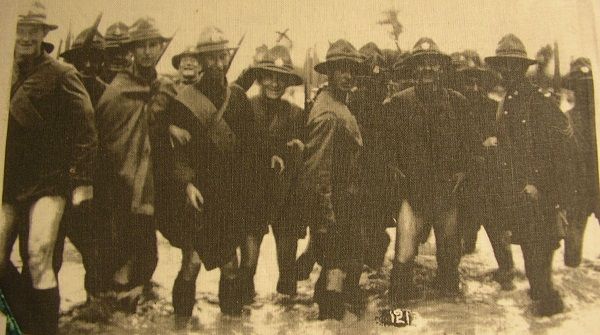 (Thomas Mitchell identified by the cross above his hat) 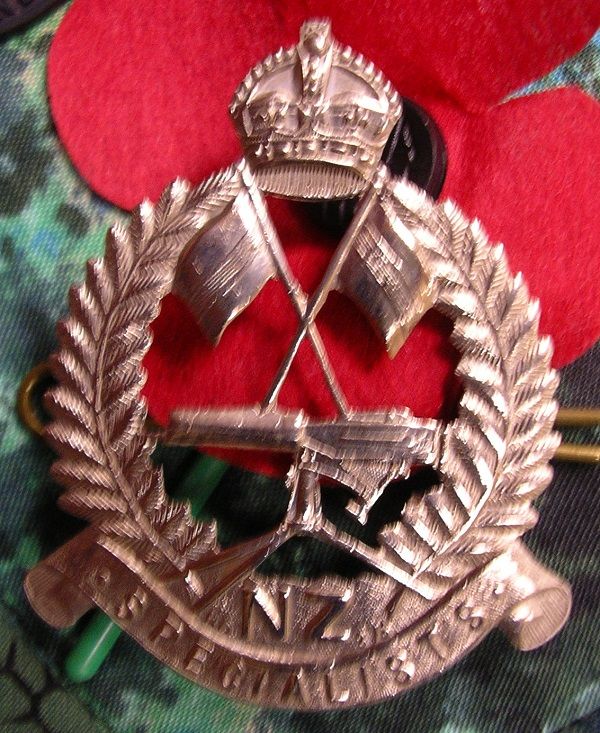 (Silver hat badge worn by Thomas Mitchell) Day in and day out we drill all the time and we are being made very fit, one of the pleasures of camp life is the descent lot of officers that we have in our company, we would all do anything for them, which shows good discipline, two of them are returned men and they seem altogether different from the untried men, but we all work together and things work off lovely every day, our daily routine orders are up at 6.15am, gargle at 6.30am, this gargle is one of the best things of camp life, prevents all diseases and it makes us feel so clean in the throats, some chaps don’t like taking it, and it is a very comical sight to see some chaps trying to gargle. The next item is to square up beds and get ready for breakfast which is at 7am sharp; as a rule our breakfast consists of porridge, stew and tea, after breakfast it is a case of duck for your life back to our hut, have a shave and get ready for parade which is at 8.10am daily. We march out to the parade ground and drill away until 11.45am, then we are marched back to our huts, and dismissed for dinner which is on at 12 noon sharp, our dinner consists of bread, jam, cheese, butter and tea, after dinner we have a little rest until 1.10pm, and we then march to the parade ground again, and go through the same proceedings until 4.30pm, then we march back to our huts, and we are then dismissed, tea at 5pm sharp, and after tea we are at liberty to do as we like until 9.30pm when everybody must be in their hut at that time, and lights go out at 10.30pm, Monday and Friday nights there is a compulsory bathing parade and everybody must go, there are decent hot showers with cold to follow. Up at the same time on Sundays, and fall in at 8.45am for church parade, and we are dismissed for the day at about 11am. We are being drilled very solid, as we have to go through the whole infantry training in two months and then final leave after which we start on our specialist training. I think that our company has stuck it very solid for fatigue duties, the reason is because they are a Reinforcement short, and these duties are falling on us pretty often, especially cook house fatigue, which is mostly peeling spuds and carrots, it is not bad work, but the fatigue that took the bun, was the night-cart, it is no wonder that they call us specialists, but we got through with the good work alright and we are not in a hurry for our next turn. All the time our company is improving in every way, especially marching, and our officers appear to be very pleased with our progress, another of our duties was Town Piquet, ten of our company were sent to Wellington to watch over soldiers who got the worse of drink, but we came into contact with a very quiet lot of boys and we were not required to arrest anyone. Fatigue again, we are united for Main Guard, that is marching up and down in front of the camp prison and guarding over the prisoners. There were six of us and each two of us had two hours on and four off, but it is a very monotonous job, anyway we carried it through alright, and after knocking off at 10am in the morning we had to get ready and march to a place called Papawai, where we had to do our shooting, we were there four days and nights and we slept under canvas and it was decent, the whole of our company done very well at the shooting, most of them passing the test. There is a town called Greytown about 2 miles from where we were camped, and one night my cobber and I went in for a walk, we went into a chemists shop to get some iodine for our sore hands, and as we were leaving the shop I picked up a pound note on the floor, I went to the man behind the counter and asked him if he ever meets honest soldiers, and I handed him the note, he says now you call back at 9pm and if it has not been claimed you can put it in your pocket, anyway I called in at the stated time, and the owner had been in and for a reward he left me five shillings, so I done not so bad. We finished our shooting on the Tuesday at dinner time and at 1pm we set out on our way back to camp and arrived there at 3pm. The next day Wednesday we started our final leave, and we are all glad to get a change of life for a few days.  (Collar badge worn by Thomas Mitchell) Last edited by atillathenunns; 03-08-14 at 04:04 AM. |
|
#386
|
||||
|
||||
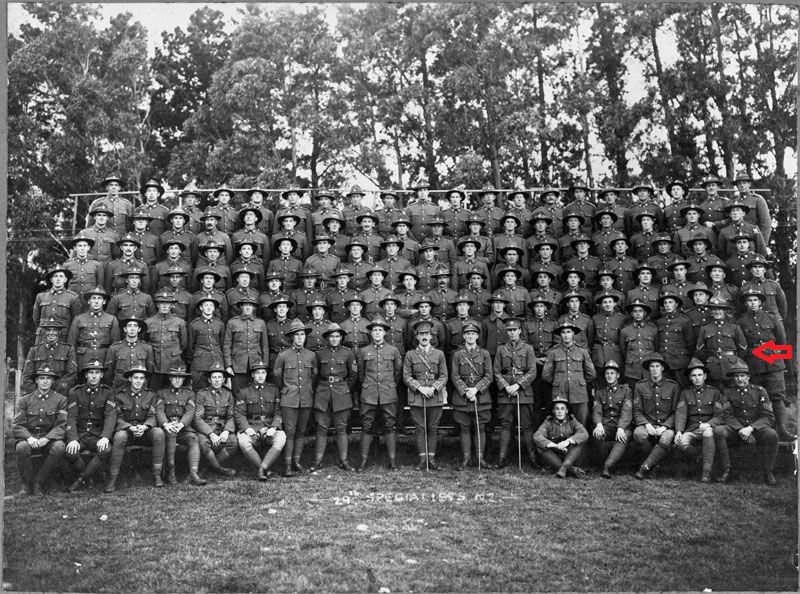 (29th Specialist Company, Thomas Mitchell identified by red arrow) 6th June 1917, Final Leave (Wednesday) The boys going south left camp left camp at 8am on Wednesday 6th June 1917, and arrived in Wellington about midday, spent the afternoon having a look around Wellington and at 8pm we caught the boat for Lyttelton, arriving there at 7am on Thursday morning, and we spent the morning in Christchurch, then we caught the 12.30pm Express for Dunedin, it was a tiresome journey, but we saw it out and arrived in Dunedin at 9.45pm the same evening. I spent a lovely weekend at home, then I left on the Monday morning for Winton, arrived there on Monday night, and left there again on Thursday morning, I spent such a lovely time in Winton, and I was treated as kindly, and no matter where I might be, I will always have my kindest thoughts for Winton, I was given such a nice send off, and I was presented with a beautiful wristlet watch, and my hopes are to be able to return to Winton to have more pleasant times. I left Winton on the Thursday morning for Tapanui, I spent Thursday night there at one of my mates places (Private A. A. Quayle) and his people gave me a most enjoyable time of it, I arrived in Dunedin on Friday night and I spent a most enjoyable weekend at my home, and I left on the Monday morning (18th June) for camp, I arrived back in camp a half day late and I was fined 15/-, which I thought was very severe, but I paid it and that was the end of it, it was a bit hard coming back to camp life again After spending a short enjoyable final leave, I soon settled down to it again and things are as before. We have now started on with our specialists training and the work is very interesting, for ten days we were doing flag drill, then we were given a test, which most of us passed, then we were given a test at reading lamps which I also passed. In the meantime I had been made a Lance-Corporal, (Promoted to Lance-Corporal on the 22nd June 1917) and I had to start and pull myself together, and it meant no more fatigue duties, and it is a blessing, we go out every day on station discipline and it is good sport, we boil the Billy for dinner and it is as good as a picnic, after doing this sort of work for about six weeks our training is about finished, I went in for the buzzer test and passed it easy, so I am now what they class a trained signaller, and I have also been given another stripe so it makes me a full blown Corporal, (Promoted to Corporal on the 3rd August 1917) and the responsibility becomes a little greater, we are now wondering when the day of sailing is due, and I think it is close at hand, and we will all be so glad of a change of scenery, not that we are extra keen to leave this dear wee country, but the camp life has become very monotonous. 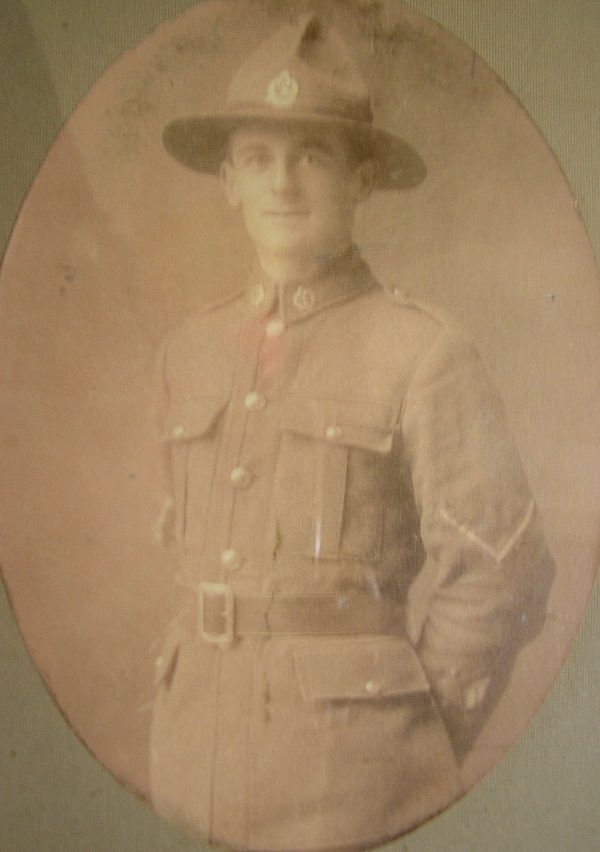
Last edited by atillathenunns; 03-08-14 at 04:22 AM. |
|
#387
|
||||
|
||||
|
At last we get news that we are to proceed to the transport (Mokoia S.S.) No. 91 on Saturday the 11th August 1917 and my dairy will now go on with best of good luck.
12th August 1917, Wellington (Sunday) Roll call at 9am and general leave for everybody until 11pm same evening, which all the boys enjoyed. The weather kept up fairly well and all the boys arrived back on the boat at scheduled time. We slept on the boat Saturday and Sunday nights. 13th August 1917, Wellington (Monday) The great day, our departure, it rained heavily, all the boys mothers and relations got soaked, we sailed at 2pm, and made straight for sea, then the fun began, everybody well. 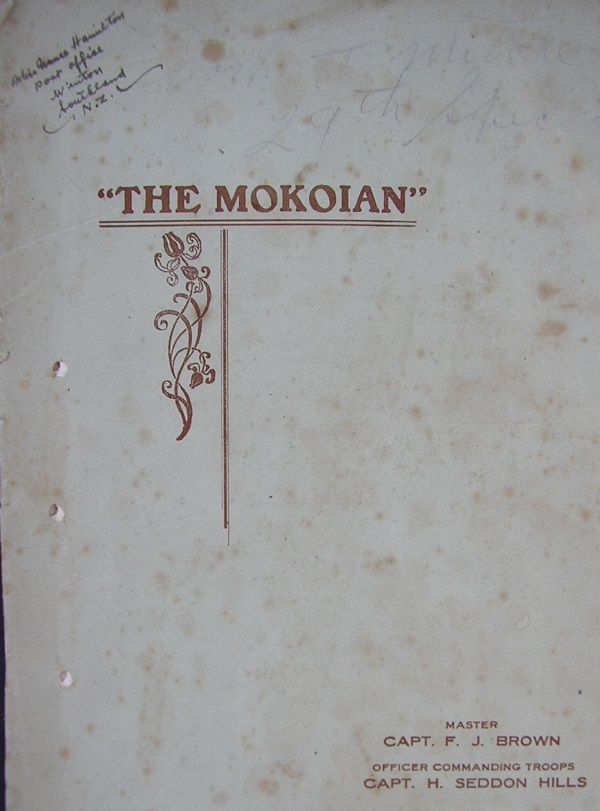 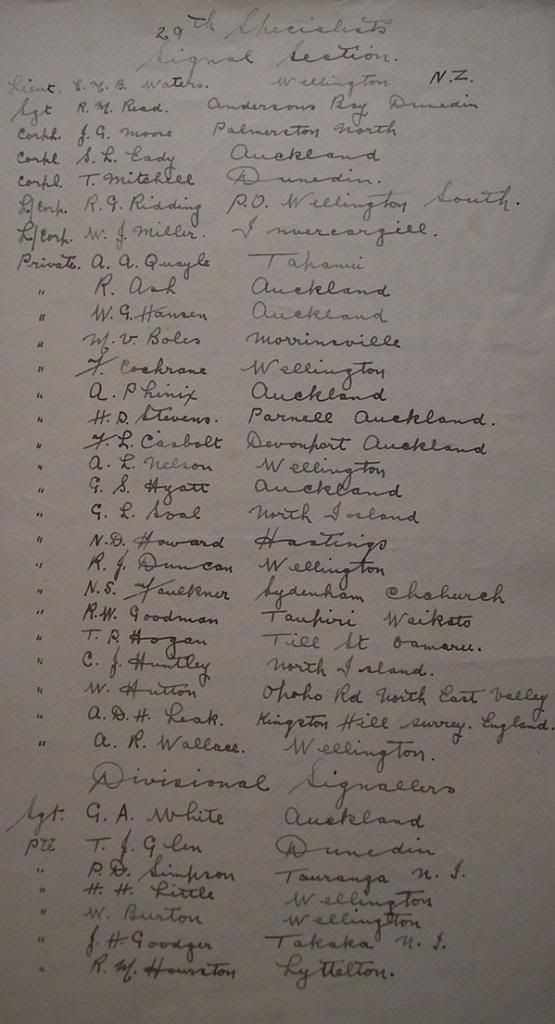  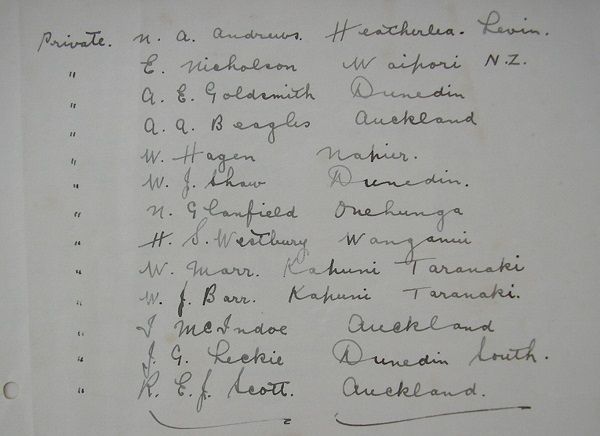  Corporal Thomas Mitchell, Service No. 53599, Specialists Company, Signal Section, 29th Reinforcements Corporal Thomas Mitchell embarked on HMNZT 91 (Mokoia S.S) on the 13th August 1917, arriving at Sling Camp in England on the 3rd October 1917, where he was posted to “E” Company (Specialists) 4th Reserve Battalion, Canterbury Regiment. On the 6th October 1917, Mitchell was posted to the 4th Reserve Battalion, Otago Regiment, and proceeded to France with their “C” Company on the 26th October 1917. On the 11th December 1917, Mitchell was posted to the 10th Company, 3rd Battalion Otago Regiment. After time spent in hospital, Thomas Mitchell was declared no longer physically fit for war service, and on the 24th August 1918 he embarked at Plymouth on the S.S. Iconic for New Zealand. 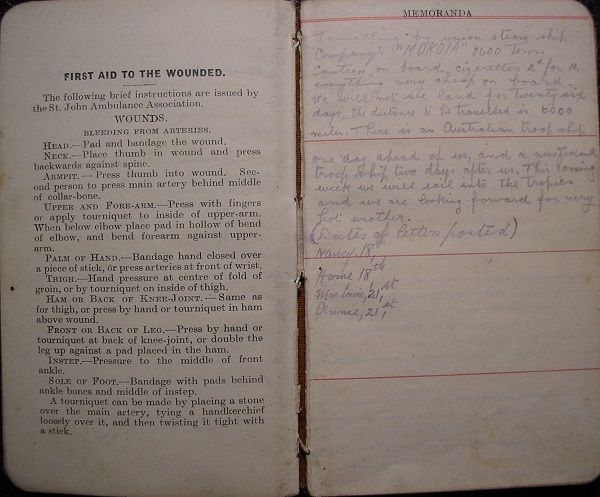 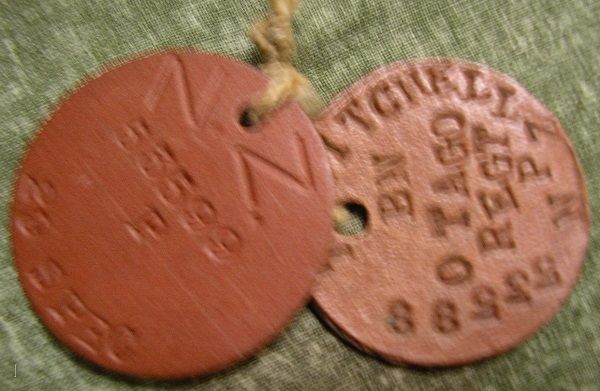
Last edited by atillathenunns; 02-08-14 at 02:25 AM. |
|
#388
|
||||
|
||||
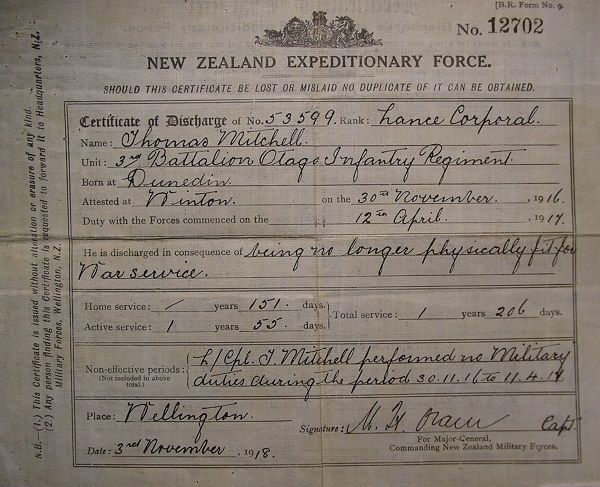 Thomas (Tommy) Mitchell was one of 91,941 New Zealanders who had volunteered to serve with the NZ Expeditionary Force during the Great War of 1914-18. His War Service at home prior to embarkation was a total of 151 days; his Active War Service was a total of one year and 55 days. The opportunity to study the numerous documents, diary, photos and Service Records that once belonged to Tom Mitchell has been of great help in advancing my own understanding of the Signal Section of the NZ Specialist Company, but more importantly Toms Silver Specialists Cap badge seems to confirm the beliefs of Laurie Osborne (One of New Zealand’s leading badge collectors) who once mentioned to me that due to some of his silver reinforcement badges having hex lugs, he believed these would have been worn by the Reinforcements themselves as opposed to being just Patriotic/Sweetheart badges that were given to relatives, friends wives and girlfriends. Although it is difficult to see in the copy of the picture I have posted in post# 386, IMO and in the opinion of others who have had a close look at Tom Mitchell’s photograph, we agree that the collar badges and buttons appear to be a different colour to the cap badge, which looks very much as though it could be a silver cap badge. 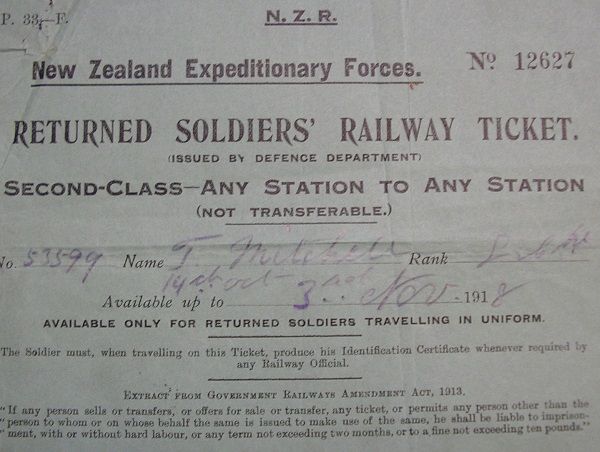 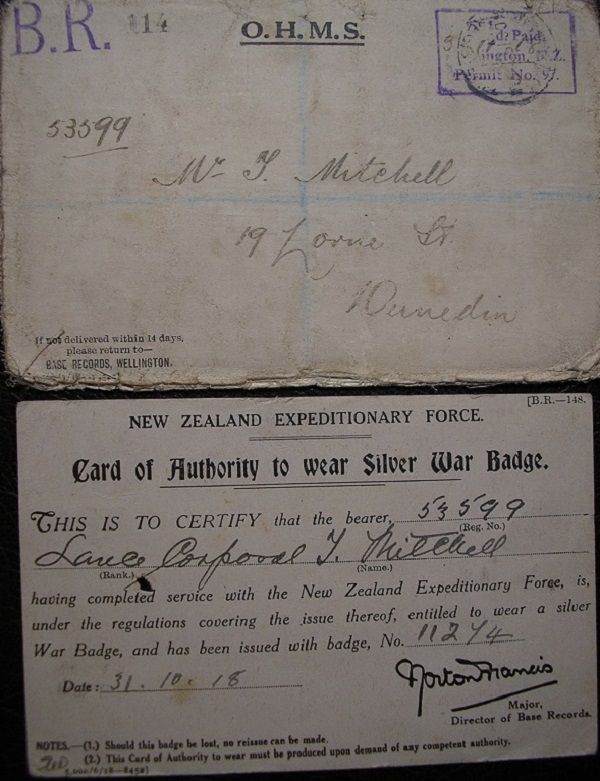 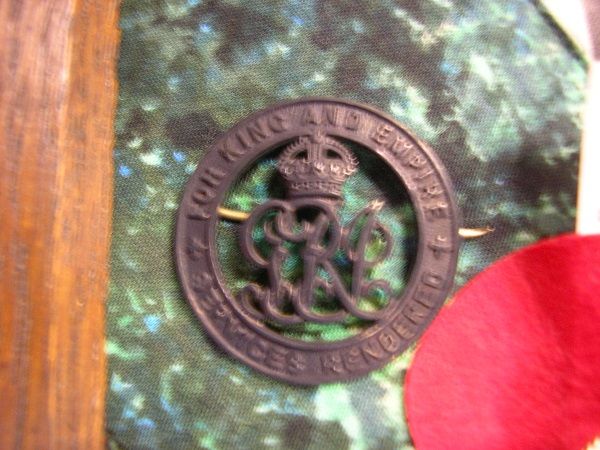  The following photo shows how Tom’s badges have been cleverly displayed and preserved by his family. 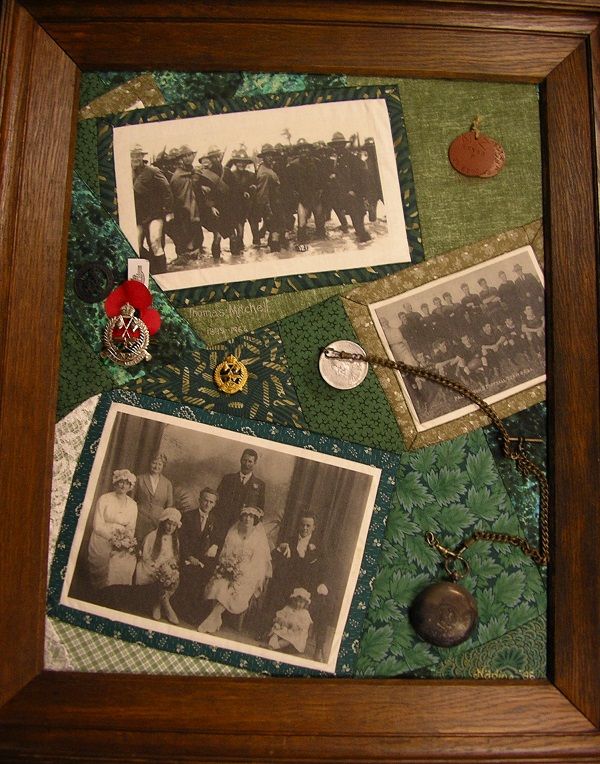 Just out of interest for the badge puritans among us, Tom's "Type 3" Specialist Company cap and collar badges have a registered design number- "876," which was issued to William Henry Haase of Wellington on the 7th August 1916. |
|
#389
|
||||
|
||||
|
An unidentified soldier (from Dunedin) wearing the Stubby barrelled NZMGC badges ,and two MG proficiency patches
|
|
#390
|
||||
|
||||
|
Quote:
Both patterns of New Zealand made MG arm patches being worn together is most unusual, and may just be included just for the photo. But the fact the spider patch has had the wreaths removed, may suggest that this was how this particular machine gunner was able to get around wearing these patches. |
 |
|
|
 |